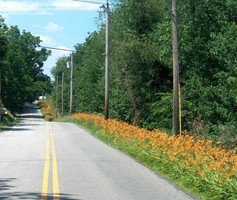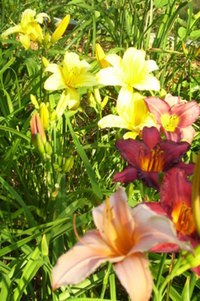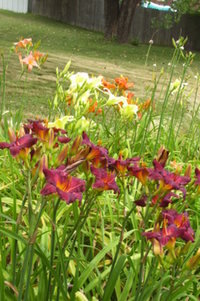





Heavily laden with black coal dust, the orange ditch lilies stood tall and proud along side the winding mountain road. With the passing of every coal truck, those tall lilies swayed from one side to the other, but they remained standing as they had for hundreds of years. The tawny colored ditch lily was the grandmother of the lovely multicolored daylilies that adorn our gardens today.
(Editor's Note: This article was originally published on June 12, 2008. Your comments are welcome, but please be aware that authors of previously published articles may not be able to respond to your questions.)
In the days of Aunt Bett and me, daylilies (Hemerocallis) grew rampant in the mountains. They grew alongside the roads, on the bank above the creek that ran beside my house, and they grew in Aunt Bett's back yard. They were the old ditch lilies, and man, they were a sturdy lot. Nothing got them down, they just grew and grew and grew. I loved them because they provided abundant color during most of the late spring and summer, and nobody ever seemed to mind if I gathered them to put in a vase. The other reason that I loved them is because I didn't have to climb to the top of the mountain to find them. You guessed it, Aunt Bett used every bit of the daylily for medicine. And I did not have to wear the stinking asphidity bag to gather daylilies. That in itself was enough to make them special.
Many years after my Aunt Bett journeys up the mountainside, I was able to have a daylily garden of my own. For awhile, my garden contained only the tawny colored ditch lilies, but as the years went by, I added more colors to my daylily collection. My daylilies came from various sources, most of them by way of my uncle who happened to be president of the Daylily Society in Louisville.
In thinking about writing of Aunt Bett's medicinal use of this particular plant, I wondered if they were native to the United States, and if they weren't, then where did they come from? What I found simply has to be shared. The use of the daylily by the ancient Chinese began before the development of written language. The nutritious flower buds were used for food and as a medicine the root and crown were excellent pain relievers. I can't help but wonder how on earth Aunt Bett knew that.
Daylilies came to Europe by way of China, Japan, Korea, and eastern Siberia as early as the 16th century. By the 17th century they arrived in North America. When they got here, they served as decoration for home gardens, early pioneers had no time to spend on delicate ornamentals. The daylily was strong and required little care, so it became quite popular among the rough homesteaders. It is a plant that multiplies well and is seldom bothered by disease.
It was in 1753 that the daylily received its present generic name when Linnaeus published his Species Plantarum. He also assigned the lemon and tawny daylilies to the same species. But it was through the efforts of hybridisers in the United States and England that great improvements have taken place with daylilies in the past 75 years. An American, A.B. Stout became the most renouned of all hybridizers. After having studied botany and earning a B.A. and then a Ph.D, he joined the staff of the New York Botannical Gardens. There he spent the following decades making an outstanding contribution to the evolution of the modern daylily. His breeding programs started in the 1920's, and during his tenure, A.B. Stout selected and introduced approximately 100 cultivars. His book, "Daylilies" was published in 1934, there have been reprints and the book is highly praised by hybridizers as well as back yard gardeners.
Aunt Bett and I did not know a thing about A.B. Stout in the late 40's, I was too young to care, and she was only interested in what the ditch lily would give her. She had daylilies in her back yard, but the ones we went to gather were located across the creek on the hillside that bordered her vegetable garden. If I took a big leap I could cross that creek in a single bound, but if I missed, right into the creek I would go. I loved to play in the creek, so unless she was in a hurry or calling for me, I missed a lot of single bounds. I began taking a muslin feed sack with me to bring home the daylily buds, because if I took a paper sack, it usually ended up disintegrating in the creek when I jumped short of the bank on the other side.
Late spring and early summer were the best times to pick the buds of the daylily. The long crunchy buds were added to the lettuce and green onion mix that was called the "spring salad". It became the "summer salad" later when tomatoes and cucumbers were ripe enough to be included. In gathering the buds, I was told to only pick one bud from each stem, the rest were left to bloom. While the daylily was in full bloom, we gathered stems and the long thin leaves. Aunt Bett chopped, then boiled them with other greens such as dandelion leaves, and before serving them for dinner, she strained off the greenish colored boiled water, saved it, and added a tablespoon of bacon grease to the cooked greens. With cornbread and her ever present glass of buttermilk, that would be her dinner. Not mine, thank you, because I knew the pig that donated the bacon grease. I was a little sentimental about the daylily contribution as well.
Anyway, sorry for that moment of digression. The boiled green water was saved and stored in sealed bottles and used as a mild pain medication. At the end of the season I was allowed to cut as many stems and leaves as I wanted to use in making a green dye. I also had already learned that boiling the wilted daylily blooms made a great yellowish dye.
We gathered roots in the fall, though she made a decoction from them, the process was slightly different from her usual decoctions. The fresh roots had to be pounded so that the juice from the root was readily available. At this point, the juice that was extracted from the roots could be added to a few drops of water and given as a diuretic to one suffering from swollen feet. As a decoction, fresh roots were boiled and the water from the boiling was administered internally, a teaspoon at a time, as a cure for cirrhosis and jaundice, and it was often used to reduce high fever.
Today I have several gardens full of colorful daylilies. Each time a new bloom is introduced, I must have it, but the humble daylily has suddenly become almost cost prohibitive. I am very happy to be surrounded by my colorful daylies, the deep reds and the soft creams are among my favorites. But without a doubt, at the top of my favorite list is the tawny ditch lily that I brought from across the creek behind Aunt Bett's house to my own home about 400 miles away. I don't eat them, I don't boil them , I simply sit and enjoy them as I remember my journeys with Aunt Bett.
www.abacom.com/chacha/gardntt.htm
www.australiandalily.com/daylily/history.htm
Look here for reference to A.B.Stout's book, Daylilies: http://www.bloomer.k12.wi.us/~tim/FOD/pubs.html#books
Go here for more books on daylilies: http://www.daylilies.org/AHSpubl.html
Decoction: DG article: Aunt Bett, Poke Sallit and the Asphidity Bag
Thanks to Janie1leigh and to Standinntherain for photos one and two, from Plant files. The remaining photos are from the author's garden.
Copyright © www.100flowers.win Botanic Garden All Rights Reserved